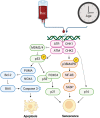A review of the pathophysiological mechanisms of doxorubicin-induced cardiotoxicity and aging
- PMID: 38263284
- PMCID: PMC10806194
- DOI: 10.1038/s41514-024-00135-7
A review of the pathophysiological mechanisms of doxorubicin-induced cardiotoxicity and aging
Abstract
The population of cancer survivors is rapidly increasing due to improving healthcare. However, cancer therapies often have long-term side effects. One example is cancer therapy-related cardiac dysfunction (CTRCD) caused by doxorubicin: up to 9% of the cancer patients treated with this drug develop heart failure at a later stage. In recent years, doxorubicin-induced cardiotoxicity has been associated with an accelerated aging phenotype and cellular senescence in the heart. In this review we explain the evidence of an accelerated aging phenotype in the doxorubicin-treated heart by comparing it to healthy aged hearts, and shed light on treatment strategies that are proposed in pre-clinical settings. We will discuss the accelerated aging phenotype and the impact it could have in the clinic and future research.
© 2024. The Author(s).
Conflict of interest statement
The University Medical Center Groningen, which employs several of the authors, has received research grants and/or fees from AstraZeneca, Vifor Pharma, Pharmacosmos, Pharma Nord, Ionis, Abbott, Bristol Myers Squibb, Novartis, Novo Nordisk, and Roche. P.v.d.M. has received consultancy fees and/or grants from Novartis, Pharmacosmos, Vifor Pharma, AstraZeneca, Pfizer, Pharma Nord, BridgeBio, Novo Nordisk, and Ionis, all paid to the institution. C.G.T. reports honoraria or consultation fees from VivaLyfe, Univers Formazione, Solaris, Summeet, Astra Zeneca, Myocardial Solutions; funding from Amgen and MSD; listed as an inventor of two patents related to HF, outside the submitted work. All other authors have reported that they have no relationships relevant to the contents of this paper to disclose.
Figures


References
-
- Ahrenkilde Hansen, P. A cancer plan for Europe. https://ec.europa.eu/info/strategy/priorities-2019-2024/promoting-our-eu... (2022).
-
- Lyon AR, et al. ESC guidelines on cardio-oncology developed in collaboration with the European Hematology Association (EHA), the European Society for Therapeutic Radiology and Oncology (ESTRO) and the International Cardio-Oncology Society (IC-OS) Eur. Heart J. 2022;43:4229–4361. doi: 10.1093/eurheartj/ehac244. - DOI - PubMed
-
- Ehrhardt MJ, et al. Systematic review and updated recommendations for cardiomyopathy surveillance for survivors of childhood, adolescent, and young adult cancer from the International Late Effects of Childhood Cancer Guideline Harmonization Group. Lancet Oncol. 2023;24:e108–e120. doi: 10.1016/S1470-2045(23)00012-8. - DOI - PubMed
Publication types
Grants and funding
- StG 71573/EC | EC Seventh Framework Programm | FP7 Ideas: European Research Council (FP7-IDEAS-ERC - Specific Programme: "Ideas" Implementing the Seventh Framework Programme of the European Community for Research, Technological Development and Demonstration Activities (2007 to 2013))
- CoG 101045236/EC | EC Seventh Framework Programm | FP7 Ideas: European Research Council (FP7-IDEAS-ERC - Specific Programme: "Ideas" Implementing the Seventh Framework Programme of the European Community for Research, Technological Development and Demonstration Activities (2007 to 2013))
- StG 715732/EC | EC Seventh Framework Programm | FP7 Ideas: European Research Council (FP7-IDEAS-ERC - Specific Programme: "Ideas" Implementing the Seventh Framework Programme of the European Community for Research, Technological Development and Demonstration Activities (2007 to 2013))
- CoG 101045236/EC | EC Seventh Framework Programm | FP7 Ideas: European Research Council (FP7-IDEAS-ERC - Specific Programme: "Ideas" Implementing the Seventh Framework Programme of the European Community for Research, Technological Development and Demonstration Activities (2007 to 2013))
- StG 71573/EC | EC Seventh Framework Programm | FP7 Ideas: European Research Council (FP7-IDEAS-ERC - Specific Programme: "Ideas" Implementing the Seventh Framework Programme of the European Community for Research, Technological Development and Demonstration Activities (2007 to 2013))
LinkOut - more resources
Full Text Sources

